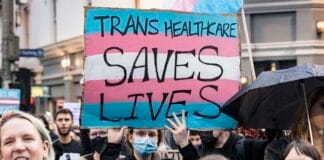During the marriage equality postal survey, the No campaign in Australia targeted trans people and gender diversity, “warning” of a future with schools where boys could wear dresses and where gender norms were under question.
Though they could not stop marriage equality, they were building on the right’s (successful) efforts to tear down LGBTIQ sex education program, Safe Schools.
Similar campaigns are underway in the US, following Donald Trump’s removal of an Obama-era decree allowing trans people to access the bathroom of their choice, and his attempt to ban trans people from serving in the military.
Now, the UK is facing its own moral panic targeting trans people, pushed by the right-wing—but sadly, their anti-trans campaign has been joined by some on the left.
The context is a proposal to amend the UK’s Gender Recognition Act to allow people to self-identify, that is, choose to change their gender without going through a mandatory two-year transition process and providing medical evidence to a Gender Recognition Panel, as is currently the case.
While the current process does not require gender reassignment surgery, transitioning publicly before changing your gender on your legal documents can put people in dangerous situations where they are “outed” as trans against their will. The UK Trans Mental Health Review of 2012 found that 81 per cent of trans people avoided some public places, such as toilets, clothing stores and gyms for fear of discrimination.
The current law also creates a situation where the medical establishment can deny a trans person access to the care they need—the same review found that 30 per cent of trans people had experienced a health professional refusing to discuss a trans related health issue with them.
Trans is an umbrella term for people do not identify with the gender they were assigned at birth. Some transition from man to woman or vice versa, while other trans people identify with neither gender, both, or are gender fluid.
In a society so based around gender roles and gender difference, trans people face extreme discrimination. In the UK, 79 per cent of trans people had experienced hate crime, according to the Galop Hate Crime Report in 2016. In the US in 2017, twenty-seven trans people were murdered.
Trans issues have come to prominence in recent years as LGBTIQ politics has gained a bigger profile, partly through the global push for equal marriage.
While the proposed changes to the UK act will not transform trans lives, they will make access to necessary services easier and potentially increase safety for trans people.
Women’s rights?
Unfortunately, some UK leftists, including teacher activists in the National Union of Teachers (NUT), and some in the Labour Party, have argued that trans rights threaten women’s rights and safety. This echoes the arguments of some radical feminists elsewhere, sometimes called “Trans Exclusionary Radical Feminists” (TERFs).
They argue that non-trans (or cis) women need women only safe spaces and bathrooms, and that trans women may pose a threat to other women in these spaces. Yet Ireland has gender self-recognition, and there is no evidence that trans women or men “posing” as trans women have attacked other women in such spaces.
There is evidence, however, that being forced into men’s spaces—like men’s prisons—has led to trans women experiencing violence.
Some feminists, such as Australian academic Sheila Jeffreys, argue that trans people “essentialise” or naturalise gender by changing gender, and because some trans people explain this as being “born in the wrong body”. But while socialists disagree there is anything innate about gendered behaviour, trans people are not to blame for gender roles. Rather, they face oppression precisely because of them.
The Murdoch press is currently running a campaign against gender neutral uniforms at Santa Sabina College in Sydney, while predominantly women childcare workers are taking industrial action against the governments and employers who impose exceedingly low pay. These are the structures of power that keep women oppressed, and divide men and women.
The fight for trans rights is linked to challenging gender roles. For example, the Safe Schools program in Australia both supports students to transition to another gender, while at the same time challenging gender segregation through specific uniform policies and homophobic policies (such as who teenagers can bring to school dances and formals).
All of us—trans or not—benefit from these freedoms.
Supporting the UK reform, and fighting for Safe Schools and trans rights at home, should be straightforward for everyone opposed to the rigidity of gender roles and oppressive ideas about masculinity and femininity that constrain human potential.
By Amy Thomas




